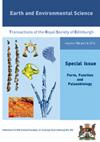综合摄影测量学、熔岩地球化学和古生物学,重新评估苏格兰受地形制约的马勒熔岩区的早期演变过程
IF 1.2
4区 地球科学
Q4 GEOSCIENCES, MULTIDISCIPLINARY
Earth and Environmental Science Transactions of the Royal Society of Edinburgh
Pub Date : 2024-01-29
DOI:10.1017/s1755691023000191
引用次数: 0
摘要
利用摄影测量法阐明了北大西洋火成岩带的一部分,即马勒西南部古新世熔岩区孤立露头之间复杂的地层关系。根据对这些摄影测量模型的解释,随后对熔岩地球化学和古植物学进行了取样。利用熔岩地球化学,特别是利用稀土元素(REE),并在多元统计的支持下,确定了高原型和斯塔法型熔岩的连贯单元。在斯塔法岩浆类型中确定了三种不同稀土元素组成的熔岩群,在西南部穆尔的高原类型中确定了四种不同稀土元素组成的熔岩群。利用解释的摄影测量模型和对突出的层间沉积岩单元及其相关的不整合的分析,了解了这些熔岩类型的分布情况。马尔西南部最著名的岩石可能是厚柱状节理熔岩,包括斯塔法岛的熔岩。REE 地球化学研究表明,斯塔法型和高原型地球化学特征的熔岩都是柱状节理面,与之前被认为是斯塔法熔岩构造相关联。相反,西南部的木尔熔岩区是由喷发到断层控制的山谷中的高原型熔岩形成的。随后喷发的斯塔法型熔岩部分填充了这一结构,最后被较年轻的高原型熔岩厚层所覆盖。高原-斯塔法-高原熔岩演替的地球化学特征表明,在地壳延伸时期,地壳深处的岩浆库被浅层熔岩所取代。这一阶段的浅层熔融造成了地形的不稳定,形成了沉积夹层和相关的不整合地貌,这就是斯塔法型熔岩演替的特征。随后的压缩构造迫使地壳重新回到深层熔融阶段。地层间的古植物成分数据表明,后期高原型熔岩的喷发很可能发生在距今约 250 万年的塞兰纪至萨尼特纪早期。本文章由计算机程序翻译,如有差异,请以英文原文为准。
Integrated photogrammetry, lava geochemistry and palynological re-evaluation of the early evolution of the topographically constrained Mull Lava Field, Scotland
Photogrammetry was used to elucidate complex strata relationships between isolated outcrops of the Palaeocene lava fields of SW Mull, part of the North Atlantic Igneous Province. Subsequent sampling for lava geochemistry and palynology was undertaken based on interpretation of these photogrammetry models. Coherent units of Plateau- and Staffa-type lavas were identified using lava geochemistry, in particular using rare earth elements (REEs), divisions supported by multivariate statistics. Lavas with three different REE compositional clusters were identified within the Staffa magma type and four within the Plateau type of SW Mull. Understanding the distribution of these lava types was achieved using the interpreted photogrammetry models and analysis of prominent interbedded sedimentary rock units and their correlative unconformities. Probably the most renowned rocks of SW Mull are the thick columnar jointed lavas, including those of the Isle of Staffa. REE geochemistry reveals that lavas of both Staffa- and Plateau-type geochemistry occur as columnar jointed facies associated with what has previously been attributed to the Staffa Lava Formation. Instead, the SW Mull Lava Field was initiated by eruption of Plateau-type lava into a fault-controlled valley. Subsequent eruptions of Staffa-type lavas partially infilled this structure, which was finally overfilled by a thick succession of younger Plateau-type lavas. The geochemical characteristics of this Plateau–Staffa–Plateau lava succession indicate that magma reservoirs deep in the crust were succeeded by shallow melts during a period of crustal extension. This phase of shallow melting induced topographical instability and formation of sedimentary interbeds and correlative unconformities that characterise the Staffa-type lava succession. Subsequent compressive tectonics forced a return to deep crustal melts. Interbed palynofloral compositional data indicate that eruption of the later Plateau-type lavas likely took place within a period of ~2.5 million years during the Selandian to early Thanetian period.
求助全文
通过发布文献求助,成功后即可免费获取论文全文。
去求助
来源期刊
CiteScore
2.00
自引率
0.00%
发文量
21
期刊介绍:
Earth and Environmental Science Transactions (formerly Transactions of the Royal Society of Edinburgh: Earth Sciences) is a general earth sciences journal publishing a comprehensive selection of substantial peer-reviewed research papers, reviews and short communications of international standard across the broad spectrum of the Earth and its surface environments. The journal prides itself on the quality of its graphics and photographic reproduction. The Editors are keen to encourage interdisciplinary papers and Transactions also publishes occasional special symposia and invited volumes of specific interest.
We are currently in the process of digitising the archive of RSE Publications, and the archive of the Transactions, dating back to 1788, will be available from the back issues link on this site.

 求助内容:
求助内容: 应助结果提醒方式:
应助结果提醒方式:


